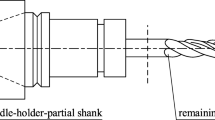Abstract
In the existing method of predicting the frequency response function of the tool point, the effect of lathe feed system is considered in the tool point frequency response function. The junction surface affects the tool point frequency response function, and the junction surface include: bearing–lead screw, lead screw–nut, working bench-guide rail, tool holder–turning tool. The lathe machining system is divided into four substructures, and the lead screw–nut junction surface and workbench-guide rail junction surface have a significant effect in the tool point frequency response function, so we mainly considered the impact of these junctions surface. Through the junction surface stiffness and junction surface damping to obtain a small response at the junction surface. And the frequency response function of the substructure is obtained by hammering method and Timoshenko beam model. Finally, the frequency response function of the substructure end is coupled with the vibration response of the lead screw–nut and workbench-guide rail by the response coupling method, and finally we get the tool point frequency response function. The CA6140 lathe was used as the experimental object, and the frequency response function of the tool point is predicted by above method. The experimental results show that the predicted tool point frequency response function has a high degree of coincidence. The method proposed in this paper can quickly get the frequency response function of the tool point which laid a foundation for the accurate prediction of static and dynamic characteristics of machine tool.









Similar content being viewed by others
References
Tang, X., Peng, F., Yan, R., et al.: An effective time domain model for milling stability prediction simultaneously considering multiple modes and cross-frequency response function effect. Int. J. Adv. Manuf. Technol. 86(1), 1–18 (2016)
Zhang, J., Li, J., Xie, Z., et al.: Rapid dynamics prediction of tool point for bi-rotary head five-axis machine tool. Precis. Eng. 48, 203–215 (2016)
Wang S.: Analyzed the stability analysis of high-speed milling and predictied the frequency response function of tool point. Northeastern University (2012)
Chai, Y.G., Meng, D.H., Long, X.H., et al.: Analysis of dynamic characteristics of high speed Spindle–Holder–Tool system. Noise Vib. Control 33(6), 25–30 (2013)
Schmitz, T.L., Donaldson, R.R.: Predicting high-speed machining dynamics by substructure analysis. CIRP Ann. - Manufact. Technol. 49(1), 303–308 (2000)
Schmitz, T., Duncan, G.S.: Receptance coupling for dynamics prediction of assemblies with coincident neutral axes. J. Sound Vib. 289, 1045–1065 (2006)
Ganguly, V., Schmitz, T.L.: Spindle dynamics identification using particle swarm optimization. J. Manuf. Process. 15(4), 444–451 (2013)
Cheng, C.-H., Schmitz, T.L., Scott Duncan, G.: Rotating tool point frequency response prediction using RCSA. Mach. Sci. Technol. 11(3), 433–446 (2007)
Zhu, J.: Measurement method of tool point frequency function based on precision modeling of milling cutters. Hit 35(16), 142–151 (2016)
Rezaei M.M., Movahhedy M.R., Ahmadian M.T., et al.: Development of inverse receptance coupling method for prediction of milling dynamics. In: ASME 2010 Biennial Conference on Engineering Systems Design and Analysis, pp. 339–346 (2010)
Qi, B.: Study on parameter identification of cutter joint and prediction of frequency response function of tool point. Mech. Eng. 10, 11–13 (2016)
Ahmadian, H., Nourmohammadi, M.: Tool point dynamics prediction by a three-component model utilizing distributed joint interfaces. Int. J. Mach. Tools Manuf. 50(11), 998–1005 (2010)
Duncan, G.S., Schmitz, T.L.: An improved RCSA model for tool point frequency response prediction. In: Proceedings of the 23rd International Modal Analysis Conference, Orlando. 30 January–3 February (2005)
Kumar, U.V., Schmitz, T.L.: Spindle dynamics identification for receptance coupling substructure analysis. Precis. Eng. 36(3), 435–443 (2012)
Mancisidor, I., Zatarain, M., Munoa, J., et al.: Fixed boundaries receptance coupling substructure analysis for tool point dynamics prediction. Adv. Mater. Res. 223(223), 622–631 (2011)
Chen, J.: Construction and parameter identification of tool holder in high speed hollow hot shank. Shanghai Transp. J. Univ. 50(17), 1005–1011 (2016). (2011, 223(223): 622–631)
Montevecchi, F., Grossi, N., Scippa, A., et al.: Improved RCSA technique for efficient tool-tip dynamics prediction. Prec. Eng. 44, 152–162 (2016)
Zhang, X.: Dynamic Characteristics and Application of Mechanical Junction Surface. China Science and Technology Press, Beijing (2002)
Zhang, J., Xu, G., Wen, S.: Study and prospect of static and dynamic characteristics of mechanical joints. J. Taiyuan Univ. Sci. Technol. 23(03), 276–279 (2002)
Author information
Authors and Affiliations
Corresponding author
Rights and permissions
About this article
Cite this article
Li, Z., Li, C., Chen, S. et al. A method of measuring the frequency response function of the tool point based on the surface of feeding system. Int J Interact Des Manuf 12, 1361–1370 (2018). https://doi.org/10.1007/s12008-017-0421-0
Received:
Accepted:
Published:
Issue Date:
DOI: https://doi.org/10.1007/s12008-017-0421-0




